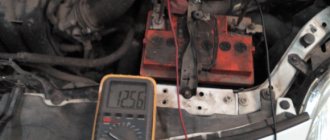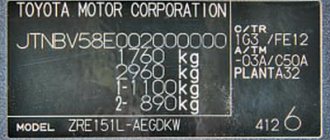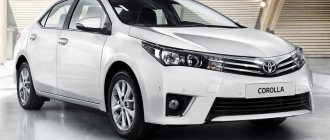Japanese developers never cease to amaze with their economical cars. In 2006, the Toyota Auris hatchback model appeared. The production version of the Auris hybrid was presented at the Geneva Motor Show in 2010 and received positive reviews. The restyled Toyota Auris Hybrid model appeared in 2016.
You might be interested
Here you can learn more about another hybrid - this is the Toyota Yaris
Exterior of Toyota Auris hybrid
The updated Auris Hybrid is attractive and stylish. On the front bumper there is a radiator grille that runs across the entire width of the car, and on the sides there are small fog lights. On the hood there are paired chrome wings, connected in the center by a corporate logo, and LED running lights are located on the sides.
Massive rear bumper with LED parking lights. A neat tailgate is available.
Toyota Auris Hybrid Exterior left view
Toyota Auris Hybrid Rear view
The hatchback profile is distinguished by a long sloping hood, a strongly inclined windshield and a smoothly sloping roof, on which a shark fin antenna is located. The blown wheel arches are equipped with 16-inch alloy wheels. Toyota Auris Hybrid has the following body dimensions: length – 4,330 m, width – 1,760 m, height – 1,480 m.
Chassis
The front axle has classic MacPherson struts, and the rear axle has a torsion beam. The latter solution does not provide excellent obedience, but it is more reliable and cheaper to repair.
- Infiniti FX50s: Return from Hell's Throat
The top version with 2.2 D-CAT has a multi-link arrangement at the rear. There were 4 levers for each wheel.
The suspension deserves special praise. Many original items can last more than 150,000 km. Even the stabilizer struts and bushings last quite a long time.
Suspension durability can result in complications when replacing front control arms. The bolt turns sour and turns in the subframe. The subframe will have to be changed or cut, and then welded.
There are known cases of faulty electromechanical power steering. The system has its own control unit in which the power steering fails. During the warranty period, the amplifier and steering wheel assembly was replaced at the expense of the manufacturer. Today this method will be too expensive. A specialized service center is ready to take on a cheaper replacement of a directly broken relay.
And after 150-200 thousand km, the steering rack may knock. For the bulkhead they will ask from 8 to 13 thousand rubles. The original rack costs about 65,000 rubles, and an analogue is available for 17,000 rubles.
The shape of the center console is controversial. It turned out to be too wide, making it difficult to accommodate the legs of tall people. The high-mounted gear lever is comfortable, but the plastic around it scratches easily.
Front wheel bearings have to be renewed after 150-200 thousand km. They are replaced assembled with the hub (3-6 thousand rubles per hub). The rear bearings are much more durable.
Interior of Toyota Auris hybrid
The interior of the updated hybrid has acquired high-quality finishing materials. The front console houses a 7-inch multimedia touchscreen display, and below it is the climate control control unit. The driver's instrument panel features a 4.2-inch TFT color multi-information screen.
The driver is offered a leather three-spoke multifunction steering wheel. The Auris hatchback uses the latest soundproofing materials.
The cabin has two rows of seats for 5 people. The front seats have good lateral support and an armrest with a spacious niche inside. The back row can accommodate 3 passengers.
Central console
Multimedia
Selector Toyota Auris hybrid
The luggage compartment volume in the hybrid is 360 liters.
Toyota Auris Hybrid has the following overall interior dimensions: length – 1,830 m, width – 1,485, height – 1,180 m.
What cars were the engines installed on?
Engines of this series have proven themselves well in tests and therefore have become quite widespread. They were used on all continents on 18 different car models of this brand. It is worth noting that the engines were installed only on Toyota products and were not sold to other manufacturers.
The motors were installed on the following car models:
| 4ZZ-FE for Russia and Europe | 1NR-FE for Russia, Europe and Japan | 1ZR-FE for Russia and Europe | 1ZR-FAE for Russia and Europe | 2ZR-FAE for Russia, Europe and Japan |
| Auris, Corolla | Auris, Corolla, Corolla Axio, iQ, Passo, Porte, Probox, Ractis, Spade, Vitz, Yaris | Auris, Corolla | Auris, Avensis, Corolla, Verso | Allion, Auris, Avensis, Corolla, Corolla Axio, Corolla Fielder, Corolla Rumion, Isis, Premio, Verso, Wish |
Engines are very common and popular. They were installed on various models of the automaker for the markets of Asia, Russia, Europe and America. Like other products of the Japanese manufacturer, they are distinguished by high quality, durability, long service life and excellent characteristics.
At the moment, today, engines of these modifications are installed on a number of Toyota models.
Their popularity and demand is associated with good characteristics, performance and cost-effectiveness. Over the years, modifications of internal combustion engines have proven themselves to be excellent.
Type of hybrid installation
The updated Toyota Auris hybrid is equipped with a Hybrid Synergy Drive (HSD) power plant. It includes: a gasoline engine, a generator, an electric motor, a variator and a planetary gear.
Hybrid engine
The car uses a series-parallel hybrid engine operation scheme. Thanks to this design, the internal combustion engine and electric motor can work in pairs or separately.
The engine starts and accelerates due to the traction of the electric motor, and the planetary mechanism distributes torque to the wheels. When the speed is picked up, the internal combustion engine comes into operation.
When the electric motor and internal combustion engine interact, the efficiency of the power plant increases. When braking, the internal combustion engine is switched off and regenerative braking occurs, in which the electric motor acts as a generator and recharges the battery.
The Toyota Auris Hybrid powertrain offers three driving modes:
1. ECO Mode
It involves the use of a hybrid installation, but mainly electricity.
2.POWER Mode
Activates the internal combustion engine and electric motor at full power.
3. EV Mode
Clean use of electricity.
Important! In addition to the usual letters on the gearshift lever, such as R (reverse), N (neutral) and D (drive forward), there is also a B. According to the developers, it must be activated during long descents. At the right moment, the engine connects and creates a braking effect. This way the brakes don't overheat.
The total power of the hybrid power plant is 136 hp.
The most common motors
The most common Toyota internal combustion engines are 1NR-FE and 2ZR-FAE. They were installed on 11 different models of the automaker, which have significant differences in many characteristics. It is worth noting that the Japanese automaker used all engine models only for its cars.
And it is the 1NR-FE and 2ZR-FAE models that are the most reliable, durable and of high quality, which confirms their prevalence, characteristics and long service life without serious breakdowns, but subject to correct and timely maintenance.
Source
Technical characteristics of Toyota Auris hybrid
The updated model of the Toyota Auris Hybrid hatchback with front-wheel drive attracts not only its stylish and sporty design, but also its good technical performance.
The main technical characteristics are presented in the table.
| Automatic transmission | e-CVT |
| Engine capacity | 1797 cm3 |
| Clearance | 140 mm |
| Wheelbase | 2600 mm |
| Turning radius | 5.4 m |
| Front/rear track width | 1525 mm/1515 mm |
| Total weight of the car | 1.675 t |
| Volume of the tank | 45 l |
| Front/rear brakes | ventilated disc/disc |
Gas engine
Under the hood of the Toyota Auris Hybrid is a 4-cylinder DOHC petrol engine 2ZR-FXE. Its volume is 1.8 liters. Engine power – 99 hp. at 5200 rpm. Torque is 142 Nm.
The operating principle of the gasoline engine is carried out according to the Atkinson cycle with combined fuel injection and is equipped with a Dual VVT-i gas distribution system.
Electric motor
In addition to the internal combustion engine, the Auris Hybrid hatchback also has an electric motor. The synchronous AC permanent magnet motor is located under the hood of the car.
The power of the electric motor is 60 kW and the torque is 207 Nm.
The hybrid makes its initial movement using only the electric motor, and then after acceleration the internal combustion engine comes into operation. Auris is capable of driving exclusively on electric power at a speed of 45 km/h.
Battery and mileage on one charge
The Auris hybrid car is equipped with a VVB and a battery. The auxiliary 12-volt lead-acid battery is located on the right side of the luggage compartment. It is used to power low voltage devices.
The high-voltage nickel-metal hydride battery is installed behind the rear seat. It consists of 28 low-voltage (7.2 V) modules connected in series. The total voltage of the VVB is 201.6 Volts. The battery can withstand up to 1500 charge/discharge cycles.
Subject to the speed limit and a full charge, the car can travel no more than 2.5 km on an electric charge. The cost of replacement will cost around 60,000 rubles.
Scheme of operation of a hybrid installation
Fuel consumption per 100 km and dynamics
The Toyota Auris Hybrid hatchback has good dynamic performance. Acceleration from zero to 100 km takes 10.9 seconds. Maximum speed – 180 km/h.
When driving on the highway, fuel consumption is 4.1 liters. In the city, the figure increases to 4.8 liters of fuel. In the combined cycle, Auris consumes 4.3 liters of gasoline per 100 km.
To reduce fuel consumption, you can use the following methods:
- keep distance between other road users;
- obey the speed limit;
- check the tire pressure, it should always be normal;
- When stopping for long periods, turn off the engine;
- Brake early and smoothly.
Transmission
Toyota Auris is exclusively front-wheel drive.
The engines were paired with a 5 or 6-speed manual transmission or a CVT. In addition, a MultiMode robotic transmission with an electronically controlled clutch was used. There are cases of premature wear of the input shaft bearing of a 6-speed manual transmission. The malfunction is detected after the engine starts. A noise appears that disappears after pressing the clutch pedal. This usually happens after 200-250 thousand km. For repairs at the service center they will ask about 20-30 thousand rubles.
Among the minor shortcomings are periodic difficulties with shifting gears, especially from “4th” to “5th”. This is usually caused by progressive corrosion of the rods between the lever and the gearbox.
The linkage system of the gear selection mechanism after 100,000 km is the main culprit of shifting problems.
The clutch of a manual transmission usually reaches 200-250 thousand km. A new set is available for 10-15 thousand rubles.
The MultiMode Automated Transmission (MMT) should be avoided.
Often its clutch wears out prematurely (9-14 thousand rubles). The replacement procedure is quite complicated and expensive (8-12 thousand rubles).
After 150-200 thousand km, the clutch release actuator may fail. Often it can be revived. Otherwise, you will have to buy a new one (over 50,000 rubles for the original or about 30,000 rubles for an analogue).
If there were complaints about the operation of the MMT, official services replaced the electronic control unit of the box with a modernized one.
- Mitsubishi Pajero IV (2006-2020) – parallels
Many owners are unhappy with the robot's reliability. Therefore, in the event of another malfunction, we decided to install the classic Aisin U340E automatic machine. Turnkey work is estimated by specialized services offering a similar service at 50-100 thousand rubles.
Hybrid reliability, breakdowns
The Toyota Safety Sense system is responsible for the reliability and safety of the hybrid Auris.
It includes:
- ABS, EBD, BAS, TCS systems;
- descent/ascent assistant;
- electronic stability control;
- signaling in case of emergency braking;
- dual-zone climate control;
- set of airbags;
- anti-theft system.
Pros of Toyota Auris Hybrid : compactness, efficiency, rich equipment, design.
Hatchback disadvantages : low ground clearance, lack of official supplies of a hybrid version.
Breakdowns - Auris often suffers from a defective engine pump. The replacement itself is cheap and easy. But this defect can cause a coolant leak.
Operation in winter
In winter, the engine and battery work perfectly. Installed heated rear window, steering wheel and seats make travel comfortable. The interior warms up in about 3 minutes. But the technical equipment didn’t work out.
Cameras and laser sensors stop working as soon as the glass is covered with an ice crust. In winter, the pre-collision braking system (PCS) often does not work. An error appears on the panel.
Reference! The PCS system is “naughty” only in severe frosts; in warm weather no failures are observed.
Options and prices Toyota Auris hybrid
The updated Toyota Auris Hybrid hatchback is offered in two trim levels: basic (price starts from 1,828,500 rubles) and G. There are more trim levels for gasoline models.
The extended package G includes:
- combined seat upholstery;
- sports seats with lateral support;
- a full set of airbags (7 pieces);
- lane keeping system;
- high beam control;
- self-dimming rearview mirror.
The cost is 1,977,200 rubles.
Reference! Prices are for new cars. The transfer was made from foreign currency at the current exchange rate.
Reviews of Toyota Auris Hybrid
Review by Sergey
More than six months have passed since the purchase of the Auris. The mileage has exceeded 7000 km. I am very pleased with the efficiency and ease of use. I haven't noticed any problems yet. In winter there are no problems, but consumption increases slightly (it has never risen above 6 liters).
Review by Roman
I bought Auris through intermediaries. I'm happy with the purchase, I've been driving it for 2 years now. During this time, I only changed the brakes, because rust appeared on them, and the squeaking noise was added. There were no more problems. For a city driver, this hatchback is perfect.











